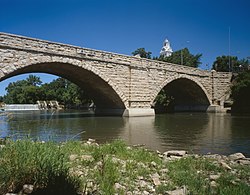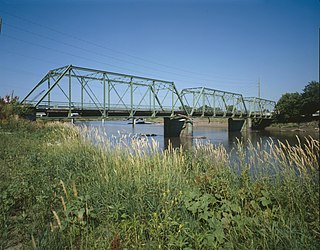
The Southwest Fifth St. Bridge is a historic structure located in downtown Des Moines, Iowa, United States. Built in 1898 after a controversy surrounding the bidding process, it is one of the last Pratt through truss bridges left in an urban setting in Iowa. The bridge was listed on the National Register of Historic Places in 1998 as a part of the Highway Bridges of Iowa MPS.
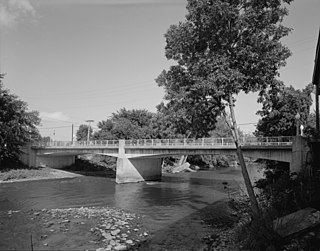
The Alden Bridge is a historic bridge in Alden, Iowa, which carries the town's Main Street over the Iowa River, United States. The concrete bridge is 150 feet (46 m) long and consists of two spans. It was built in 1936 to replace an earlier wooden bridge that had begun to deteriorate. The Weldon Brothers Construction Company supervised the bridge's construction, while the Iowa State Highway Commission designed the structure; it was one of the first bridges designed by the ISHC, which used similar plans for many other bridges in the state. Labor for the construction effort came from the Works Progress Administration, providing jobs for many of Hardin County's unemployed residents. The bridge was dedicated on July 4, 1936, as part of Alden's Independence Day celebrations.
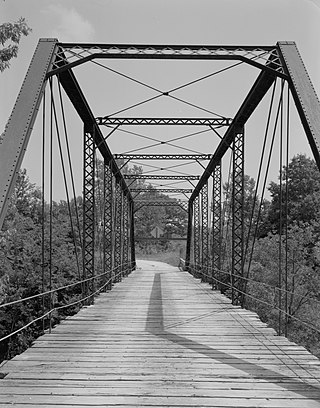
The Grand River Bridge is a historic bridge located west of Leon, Iowa, United States. It spans the Grand River for 235 feet (72 m). A 7-panel Pratt Pony truss spans the main channel of the river, with a 4-panel Pratt pony truss/bedstead and timber stringer that forms the approach span on the west side. It was built by bridge contractors Daniel and Webster for $2,980 and completed in 1890. The bridge is no longer in use for vehicular traffic. It was listed on the National Register of Historic Places in 1998.

The Wapsipinicon River Bridge is a historic structure located in Independence, Iowa, United States. It spans the Wapsipinicon River for 341 feet (104 m). The Buchanan County Board of Supervisors contracted with the Miller-Taylor Construction Company from Waterloo, Iowa, to build the new bridge on the south side of Independence for $37,680. However, high water created problems during construction, and the bridge was completed in January 1927 for $57,530. It replaced an earlier two-span iron truss bridge. This bridge is a concrete filled spandrel arch bridge with four spans. It was designed by the Iowa State Highway Commission, and continues to carry vehicle traffic. The bridge was listed on the National Register of Historic Places in 1998. There is a similar bridge upstream in Independence that was built in 1918.
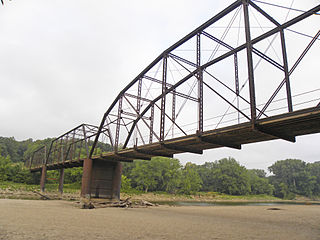
Boone Bridge 2, also known as the Wagon Wheel Bridge, was a historic structure that was located west of Boone, Iowa, United States. It spanned the Des Moines River for 703 feet (214 m). The Boone Commercial Association and the Boone County Board of Supervisors disagreed over the location of a new wagon bridge over the river. The county wanted the new bridge west from Eighth Street in Boone, closer to the Chicago and North Western Railroad's Boone Viaduct. The businessmen wanted to rebuild the Incline Bridge. The dispute was resolved when the Commercial association offered to buy the Incline Bridge. The county contracted with the Iowa Bridge Company to design and build the bridge, which was completed in 1910 for $77,900. The bridge consisted of a long-span Pennsylvania truss over the main channel of the river and three Pratt trusses over the floodplain. It was listed on the National Register of Historic Places in 1998.

Nodaway River Bridge is located west of Grant, Iowa, United States. It spans an arm of a small pond in Pilot Grove County Park for 70 feet (21 m). The Montgomery County Board of Supervisors accepted a petition from S. M. Smith to build a bridge over the Nodaway River south of Grant in June 1876, and another bridge over the Nishnabotna River at the same time. The county contracted with the Missouri Valley Bridge & Iron Co. of Leavenworth, Kansas, to design and build the Nodaway River bridge, which was completed later the same year for $1,000. The bridge consists of a single-span Bowstring arch-truss with a wood deck. It remained in use as a road bridge until 1968, when it was moved to the park for use as a pedestrian bridge. Even though it is no longer in its historic location and used for its historic function, the bridge was listed on the National Register of Historic Places in 1998 as an example of early transportation development in Iowa.

The Nishnabotna River Bridge is located southwest of Manilla, Iowa, United States. It carries traffic on 310th Street over the Nishnabotna River. Steel was in short supply during World War II as a part of the war effort. Many bridges built across the state were built in this era with timber, especially small-scale bridges. Heavy flooding washed out 27 bridges and culverts in Crawford County in May 1945. The county board of supervisors used emergency funds to build new bridges. They bought several steel superstructures from the Des Moines Steel Company to replace the wash-out spans. The bowstring arch-truss structures appear to have been designed by H. Gene McKeown, a civil engineer from Council Bluffs. This bridge is one several similar structures built in the county, and one of five that still remain. The bridge was listed on the National Register of Historic Places in 1999.

Eveland Bridge is located southwest of Oskaloosa, Iowa, United States. It carried traffic of Fulton Avenue over the Des Moines River, spanning 647 feet (197 m). After receiving multiple petitions, the Mahaska County Board of Supervisors decided in April 1875 to build a bridge, replacing a ferry service that operated at this point along the river beginning in 1854. They contracted with the Fort Wayne Bridge Works of Fort Wayne, Indiana, to build the new bridge for $25,200. It was designed by C. W. Tracy, a civil engineer. The Whipple through truss span was completed in the summer of 1877. This style was rarely chosen for wagon trusses in Iowa, which means few were built and fewer remain standing. Its deck has subsequently deteriorated and the bridge has been closed to traffic. The Eveland Bridge was listed on the National Register of Historic Places in 1998.

The Kilbourn Bridge is located south of Kilbourn, Iowa, United States. It carried traffic on Lark Avenue over the Des Moines River for 855 feet (261 m). In 1890, the Van Buren County Board of Supervisors contracted with the Western Bridge Company of Chicago to build a bridge at the Kilbourn ferry crossing. It was destroyed in a flood in 1903, and the Board of Supervisors put off replacing the bridge until 1907, then all the proposals came over the $20,000 limit. They removed the limit the following year. The six-span bridge was designed by the Iowa State Highway Commission (ISHC), and built by the Ottumwa Supply and Construction Company of Ottumwa, Iowa. It was the first large-scale engineering project undertaken by the newly formed ISHC. The Kilbourn Bridge was listed on the National Register of Historic Places in 1998.
The Okoboji Bridge is located southwest of Milford, Iowa, United States. The 83-foot (25 m) span carried traffic on 180th Avenue over a branch of the Little Sioux River. The Dickinson County Board of Supervisors hired a local contractor to build a bridge across the straits between East and West Okoboji Lakes in 1859. The wooden structures had to be rebuilt in 1874–1875. There was a desire for a drawbridge at this point to allow for steamboats to navigate between the lakes. Three different swing spans were built at this location in the 19th century. When the third span deteriorated the board of supervisors contracted with the Clinton Bridge and Iron Works of Clinton, Iowa to build a permanent span here in June 1909. The Pratt/Warren pony truss structure was completed later that year for $1,550. The bridge and the road were incorporated into the U.S. Highway System, and it was placed under the aegis of the Iowa State Highway Commission. In 1929 it was replaced with a fixed-span concrete girder structure. At that time the 1909 truss span was moved to Okoboji Township to span a branch of the Little Sioux River. It was listed on the National Register of Historic Places in 1998. The span has subsequently been abandoned.

Red Bridge is a historic structure located northeast of Postville, Iowa, United States. It spans the Yellow River for 128 feet (39 m). The Allamakee County Engineer designed the timber Pratt through truss structure, and it was erected by a local contractor named A. L. Powell in 1920. Built for $2,304.74, it is composed of timber compression members and forged iron tension members. The structural steel was provided by the Worden-Allen Company of Milwaukee, and City Lumber provided the timbers. At some point it was abandoned and the timber deck and stringers were removed. It is the last uncovered timber truss bridge remaining in Iowa. The bridge was listed on the National Register of Historic Places in 1998.

The Mederville Bridge is a historic structure located in the unincorporated community of Mederville, Iowa, United States. It spans the Volga River for 156 feet (48 m). This is one of only a few open spandrel arch bridges constructed in Iowa. Designed by the Marsh Engineering Company of Des Moines, it replaced a covered timber Howe truss bridge. Clayton County rejected all of the original bids to build the structure when they all came in too high. Six companies bid a second time on the project, and F. E. Marsh and Company of Des Moines won. They completed in the bridge in 1918 for $17,454.32. It was listed on the National Register of Historic Places in 1998.

The Twin Bridge is a historic structure located in Twin Bridge Park southwest of Fayette, Iowa, United States. It spans the Little Volga River for 80 feet (24 m). The Fayette County Board of Supervisors contracted with N. M. Stark and Company of Des Moines to build almost all of its bridges between 1900 and 1913. This concrete Luten arch bridge was completed in about 1910 using a patented design by Indianapolis engineer Daniel Luten. Stark was a licensee for Luten and they built multiple bridges using his designs under a patent royalty agreement. The Twin Bridge was listed on the National Register of Historic Places in 1998.
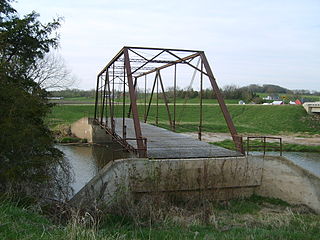
Mill Race Bridge is a historic structure located northwest of Eldorado, Iowa, United States. It spans the Turkey River for 120 feet (37 m). Its name is derived from its location near a riverside mill. Horace E. Horton, a civil engineer from Minneapolis, had designed wagon bridges for Fayette County in the 1880s. When he joined the Chicago Bridge & Iron Company late in the decade, he took the county with him as a client. Chicago Bridge & Iron was responsible for providing the county's bridges in the 1890s. This bridge was completed about 1892, but its concrete abutments are not original. While it remains in place, but it has been replaced by a newer span. The Mill Race Bridge was listed on the National Register of Historic Places in 1998.

West Auburn Bridge is a historic structure located northwest of West Union, Iowa, United States. It spans the Turkey River for 181 feet (55 m). In 1880 the Fayette County Board of Supervisors contracted with Minneapolis engineer Horace E. Horton to design and build this bridge. The Whipple through truss bridge was completed for $7,598.79. At the time of its nomination it was one of only eight bridges of this design known to exist in Iowa. The West Auburn Bridge was listed on the National Register of Historic Places in 1998.

Hale Bridge is a historic structure located south of Anamosa, Iowa, United States. It spans the Wapsipinicon River for 296 feet (90 m). It is an example of a bowstring through-arch truss bridge. Perhaps thousands of these bridges were built in Iowa in the late 1860s through the 1870s. However, by 1992, fewer than twenty survive.
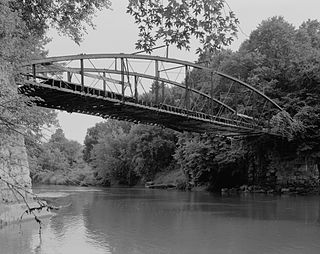
Corbett's/Eby's Mill Bridge is a historic structure located northeast of Scotch Grove, Iowa, United States. It spans the Maquoketa River for 128 feet (39 m). James S. Applegate established a gristmill near this location in 1858. He was joined by John Corbett, who obtained ownership by 1868 and expanded the operation and added a sawmill. He petitioned the Jones County Board of Supervisors for an iron bridge at this location in 1870. They agreed to pay two-thirds of the construction costs with the final third paid for by local subscriptions. The contract to construct this bridge and a similar span in Monticello was made with Miller, Jamison & Company of Cleveland. Both are single span bowstring truss bridges that were completed in November 1871. This bridge has always been identified with the mill. Samuel Eby acquired it in 1875, and it remained in the family until 1913. The bridge was originally on a loop road that circled behind the mill pond. When County Road X73 was created in 1958 it bypassed the bridge to the south. The bridge has been under private ownership ever since. It was listed on the National Register of Historic Places in 1985.

The Winnebago River Bridge was a historic structure located north of Mason City, Iowa, United States. The span carried U.S. Route 65 over the Winnebago River for 122 feet (37 m). This is the second span at this location. The stone abutments from the previous bridge were utilized in this one. They were sheathed in concrete by the Concrete Engineering Company, and William Henkel of Mason City constructed the bridge. It is composed of three concrete spans with a 70 feet (21 m) center span cantilevered from shorter anchor spans. It was listed on the National Register of Historic Places in 1998. A second span has subsequently been built to the east in 1969.
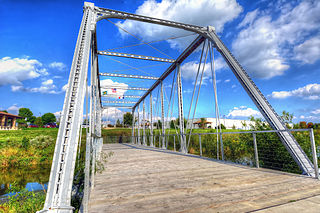
The Dunleith and Dubuque Bridge, also known as the White Water Creek Bridge and the Bergfeld Recreation Area Bridge, is a historic structure located in Dubuque, Iowa, United States. This span was part of a seven-span approach to one of the first bridges constructed over the Mississippi River. It was part of a railroad bridge that connected Dubuque with Dunleith, Illinois, now known as East Dubuque. The bridge was fabricated by the Keystone Bridge Company of Pittsburgh, Pennsylvania. Andrew Carnegie himself traveled to Dubuque to advocate for his company to build the bridge. The bridge was erected by Reynolds, Saulpaugh and Company of Rock Island, Illinois. The approach, of which this iron truss was a part, was completed in 1872. It was used by the Illinois Central and other railroads.

Keigley Branch Bridge is a historic structure located northeast of Gilbert, Iowa, United States. It spans the Keigley Branch for 47 feet (14 m). The Iowa State Highway Commission was re-formed in 1913 and they developed standard designs for smaller bridges. One of their designs was an alternative to the Luten arch. They were built throughout the state in the 1910s and 1920s. This is the oldest remaining arch bridge from that era. The Koss Construction Company of Des Moines completed it in 1913 for $3,384.85. The bridge features a medium-span arch with concrete-filled spandrels, paneled guardrails, a corbeled arch ring, and two-tone concrete detailing. The Keigley Branch Bridge was listed on the National Register of Historic Places in 1998.
